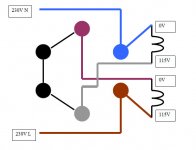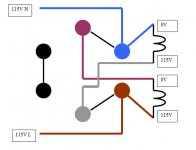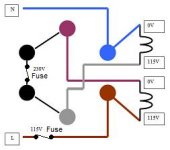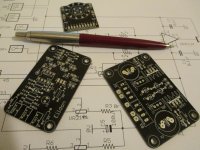please excuse the crude drawing but its the best i could do.
the drawing is representing a DPDT voltage selector switch so i can wire up dual voltage supply. i have not represented a PE or Fuse but they will be included.
have i got it right 😕
230v
View attachment 612706
115v
View attachment 612707
Thanks
Looks good. You need to pay attention to the phasing, and it looks like you do understand that.
i have not represented a PE or Fuse but they will be included.
Separately fuse EACH primary.
Looks good. You need to pay attention to the phasing, and it looks like you do understand that.
blind luck more then anything 😉
Separately fuse EACH primary.
planning on using IEC fused/switched inlet then onto voltage selector then onto trafo.
Separately fusing each primary is not the way to go. Suppose just one of the fuses failing. With 2 primaries in parallel (115V) one should use one fuse just like the 230V situation with both primaries in series. Any overcurrent situation should result in the device being completely disconnected. In the 115V situation both primaries must always be connected in parallel i.e hardwired.
Please note these 115/230 switches to be famous user error devices possibly resulting in catastrophic failures. If you don't relocate better wire your device for the area you live in. If you leave some excess wiring you can rewire later for another mains voltage. Safer and less prone to user errors.
Please note these 115/230 switches to be famous user error devices possibly resulting in catastrophic failures. If you don't relocate better wire your device for the area you live in. If you leave some excess wiring you can rewire later for another mains voltage. Safer and less prone to user errors.
Last edited:
Hi again. Hope you're well. I do wonder why you want to do this? This kind of selection is usually provided as a hard wired option on a psu board.
You could connect the fuses like this.
The one for 115 volts can stay in, it has to be twice as strong.
Mona
Mona, please explain what the purpose of 2 fuses in series is ? The one indicated as "115V" is the only one that is necessary and, like you stated, must be dimensioned depending on mains voltage. Normally this is mentioned like 115V/0.2A slow, 230V/0.1A slow.
Last edited:
You could connect the fuses like this.
The one for 115 volts can stay in, it has to be twice as strong.
Mona
personally think single inlet fuse is good enough, use fuse same as voltage. i could be wrong though. anyway the IEC inlet i'm using only has a place for one fuse on the Live (Space is TIGHT) fuse is only to protect circuit. if you go sticking you fingers in a live piece of equipment without knowing whats what then you deserve to get a shock.
Hi again. Hope you're well. I do wonder why you want to do this? This kind of selection is usually provided as a hard wired option on a psu board.
was just curious as to how this was done and the trafo will be hard wired, helps me understand whats what 😀
my 'PSU' (regulation) board is tiny and dont have space and its at the front of the case 🙁
case is 103mm x 160m x 53mm and there is motor control, regulation, IEC inlet, 6pin din outlet and 2x12 30va trafo.
Just about everything has been said, but agree with jean-paul that safety precautions musy be taken. A simple standard switch on the outside of the enclosure won't do. It needs to be located inside the enclosure, or the type that can't be accidently actuated, such as a pull detent, recessed slide, etc.
Hi again. Hope you're well. I do wonder why you want to do this? This kind of selection is usually provided as a hard wired option on a psu board.
Depends on where you live 😉 ,sometimes you are *forced* to do so.
Brazil is a dual voltage Country, sometimes a street divides two boroughs, one side is 110V, the other 220V or, say, Sao Paulo is 110, Santos its adjoining port city is 220V, and sometimes inside Sao Paulo proper you find 220V buildings 😱
So most appliances, and practically all guitar amps have 220/110V switches **in the front panel** , so you remember to set them properly.


An externally hosted image should be here but it was not working when we last tested it.
An externally hosted image should be here but it was not working when we last tested it.
And for long years, British products which expected to be also exported all over the way, had very prominent, user operated voltage selectors:
The very dangerous VOX voltage selector:

Modern version:

Marshall:

If you have only one fuse you must change it every time an other voltage is chosen.The 115 one to big for 230 and to small the other way around.Mona, please explain what the purpose of 2 fuses in series is ? The one indicated as "115V" is the only one that is necessary and, like you stated, must be dimensioned depending on mains voltage. Normally this is mentioned like 115V/0.2A slow, 230V/0.1A slow.
What i showed give a 0.1A for 230volts, the 0.2A still in place does no harm.And with 115volts service the 0.1A is short circuited.
No more fuses to change.
Mona
Depends on where you live 😉 ,sometimes you are *forced* to do so.
This is strange. So in one country you never know what mains voltage you encounter ?! Could be solved in a few months time. When money is tight is can be done in years as power usage only goes up and transformers need to be replaced for higher rated ones in many areas. Having one mains voltage is more efficient and goods will be cheaper as the switch can be omitted. No more defects from wrong switching too. Maybe priorities are different over there but choosing a standard is best for a country and its population. Long term planning..... In the cases where I have seen issues like these often there simply was no drive to improve the situation. When a grid was calculated too light simply doubling the high voltage to be able to continue energy delivery was done. Hereby users were forced to buy new quite expensive transformers. Decision to do this was done without any input from the population and when the day came the ones that had not adapted saw their fuses blowing. Lack of planning, lack of foresight, lack of system, lack of compassion for the own population.
&Mona:l I understand. It will work OK. I am not used to seeing 2 fuses in series. Probably because of selectivity in normal situations with just 1 mains voltage.
Last edited:
- Status
- Not open for further replies.
- Home
- Amplifiers
- Power Supplies
- 115/230vac selector switch




 Fun is what it's about.
Fun is what it's about.